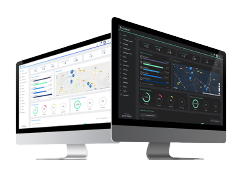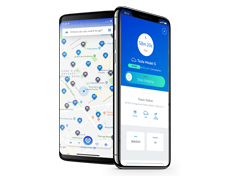
Smart City: the intelligent city of the future
Sustainability | EnvironmentSmart and sustainable cities at an economic, social and environmental point of view through energy efficiency and innovative technologies.
Smart cities are the cities of the future and incorporate innovative systems that seem to be taken from a futuristic fiction film.
In other words, an intelligent city is based on a sustainable urban plan that meets the needs of its citizens by focusing on a sustainable economy, society, operability and environment, through the use of the most innovative technology and renewable energies.
Now let's see why they arise, how they work and some real examples.
How does a Smart City come about?
Nowadays, many people who live in the villages migrate to the cities because these are places with more employment, as well as social and educational opportunities. The United Nations, in its report on demographic change, states that by 2050 70% of the world's population will live in urban areas.
Overpopulation in the world's major cities and desertification in the villages are factors which require cities to adapt in order to ensure a quality of life for all their inhabitants. In fact, the evolution from 1984 to 2016 of the growth of large cities in the world is incredible. Without going any further, the United Nations presents in its same report that we are already facing problems in ensuring adequate housing and infrastructure for urban citizens.
When creating or developing a Smart City it is important to bear in mind its strength, meaning a characteristic that makes it unique and consequently rich. Its physical characteristics also need to be taken into account, such as which renewable energies are most valuable for the city's climate.
But we will not only look at the physical particularities, but also at the social ones. After all, a city does not exist without its citizens and, for this reason, the type of society that resides in each particular city and what its needs and behaviours are must be taken into account.
Subsystems of a Smart City
Smart cities can be organised through different subsystems that cover the educational, economic, social, mobility and environmental demands of the metropolis:
Distributed generation
The current system of electricity generation is based on power plants far from the points of consumption that distribute electricity to the population.
By contrast, distributed generation offers the creation of electricity close to the people' points of consumption. This electricity would be generated by small renewable energy sources such as solar panels in homes, isolated wind turbines or electric cars.
The main environmental advantage of distributed generation is the low loss of electricity to the grid, as this is a major step forward compared to the current form of electricity distribution.
Nowadays, energy is produced in areas far from the population and during its transport a considerable amount of energy is lost to the network. Therefore, thanks to this subsystem this problem disappears completely.
Furthermore, if we link distributed generation with the electric vehicle, in an intelligent city these types of vehicles will be able to deliver energy from their batteries to the electricity supply network, thus achieving greater energy efficiency.
eMobility
This is one of the points that, as you can imagine, we are most excited about explaining, as at Place to Plug we are fighting to promote electric and sustainable mobility and we have always upheld that the electric vehicle is the future. And, once again, it is demonstrated that we are right in considering that one of the subsystems of the Smart City is the implementation of the electric vehicle with its respective charging points.
The main function of electric mobility is to implement an ecological and zero emission mobility and, to ensure this, this subsystem promotes the development of a wide network of chargers for electric vehicles, both public and private.
But this is not all, as the eMobility concept also promotes mobility on foot, by public transport and by electric bicycle or scooter.
In Dubai, for example, the Sustainability City project is underway, where no combustion cars are allowed and there are 250 charging stations throughout the whole city.
Smart Grids
This is efficient electricity management based on intelligent networks capable of optimising electricity generation and distribution processes.
These networks contain a bi-directional energy flow capable of transmitting electricity in both directions, providing energy to consumers and collecting it from them through a set of data, both for electricity generating companies and for consumers.
This system is intrinsically linked to the electric vehicle, since thanks to the Smart Grid system, EVs can be charged from the electric grid and/or distribute electricity to such grid in a bidirectional way. Furthermore, through this subsystem, we can charge the vehicle during the lowest demand peaks, in order to enjoy a more economical charge. Pure energy efficiency!
Smart Metering
This subsystem is made possible by intelligent tele-counters that measure the water, energy or gas costs incurred by each user. This energy consumption measurement is carried out remotely, sending information to the user and to the electricity operator.
On the one hand, the user can know how much energy is consumed in real time and decide when he or she wants to connect to the network. On the other hand, the electricity operator has the data to be able to measure the electricity consumption of the users in order to prevent consumption peaks and to provide a balanced distribution of electricity. What does that mean? A definitive goodbye to estimated bills!
Suez Smart Solutions, for example, presents different Smart Metering solutions specialised in the measurement and management of water costs. ON'connect is the solution created by this international group for the mass remote reading of water, electricity and gas meters.
Smart Buildings
Buildings and homes in smart cities generate sustainable energy. So, what exactly does that mean? It means that apart from generating this energy, they will also use it in a way that makes them energy self-sufficient. In other words, they will not need to be supplied with energy that comes from the outside thanks to their own renewable energies used, such as solar or aerodynamic energy or through innovative technological systems that allow them to generate energy that meets the needs of the building.
These are constructions that have been carefully studied both in terms of their orientation and their architectural forms in order to make the most of the energy provided by nature itself. In addition, this subsystem integrates home automation in such a way that the user hardly has to worry about the operation of the building.
Smart Sensors
This subsystem includes a whole series of sensors spread throughout the city that collect information in real time, so that this data is transmitted to the cloud and from it to different electronic devices such as smartphones or computers. Thanks to the data detected by sensors, a great deal of energy and time can be saved in many aspects of citizens' daily lives.
For example, there can be sensors to detect free parking spaces, to know the state of the rubbish containers or for the lighting of the city, in such a way that they represent an important saving in electricity and time when looking for a parking space, when collecting the rubbish from the containers and when lighting a street where no citizen is circulating.
Smart Citizen
All in all, the real players in any intelligent city are the citizens who live in them. Therefore, this subsystem includes all those citizens who agree with its operation and who actively collaborate so that it is organised in the most sustainable and efficient way possible.
Therefore, these are people who are very aware of the evolution of populations, of the climate crisis and with a broad capacity to constantly adapt to new changes and innovations proposed by technology and also with the desire to apply sustainability criteria in their daily lives.
ICT
And, finally, information and communication technologies could not be left out! Obviously, the implementation of ICT takes a lot of influence on the functioning of these intelligent cities, since they are the technologies capable of transmitting information to citizens and administrative entities in order to obtain optimum and efficient management of the city.
Smart Villages
An alternative to the depopulation of rural villages that we have been experiencing for years is the development of intelligent villages, based on innovation and the revitalisation of rural services in order to guarantee an innovative and comfortable rural life.
Furthermore, a concept that sounds in line with smart villages - in addition to supporting economic, social and environmental sustainability first hand - is Agriculture 4.0. This new concept applies technology to agriculture by installing a series of sensors or drones to improve the treatment of agriculture, such as the state of soil moisture and advanced disease prevention, among others.
Well, Smart Villages can also have all the subsystems that make up a Smart City (distributed generation, eMobility, Smart Grids, Smart Metering, Smart Buildings, Smart Sensors and ICT) to provide new jobs and opportunities that, consequently, manage to form the new population of rural areas: new Smart Citizens.
Rural areas are certainly also part of the solution!
🚙 And how does Place to Plug participate in the development of the future cities?
Place to Plug is part of the eMobility system, managing the charging points and offering the best recharging experience for electric vehicle drivers, while continuing to evolve technologically to implement systems in line with the environment and thus being able to live in a more sustainable world.



Leave a comment